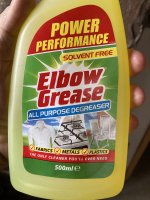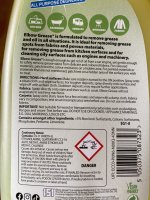I always knock out any dents, but depending on their 'sharpness' I might heat the metal to a red heat to make it easier and avoid possibly provoking a split in the metal. (iirc the metal is thicker than a body panel so needs more 'persuasion. Check the drain plug thread is fit to fit for purpose, check there are no cracks in the threaded ring that is welded to the oil pan and that it's not loose. Check and if necessary, dress flat any distortion on the oil pan gasket flange - do not over-tighten this gasket when refitting the oil pan. If all is now well, clean (including the inside) and repaint (the outside only).
Valves, hard to say. Need more cleaning, scrape off as much of the carbon, then either finish on a wire wheel on a bench grinder/angle grinder/electric drill. I always keep valve, springs, caps, retainers etc. and cam followers/shims etc. segregated so they can be refitted in their original locations.
One quick way to clean/polish valve head is to hold them in a drill chuck (a bench drill is best) and clean them by holding a strip of emery cloth/abrasive paper against them while they're revolving.
Check there is no ridge/step on the valve stem where it's travel in the guide ends.
Check there is no splitting/cracking evident on the very edge of the valve head,
Check the edge of the valve head isn't like a 'knife-edge' due to wear or overgrinding/lapping-in, it should be a minimum of 2?mm at the periphery for durability.
To check valve guides, place the valve partially back into it's guide, place your finger over the top of the valve guide and pull out the valve - if there is a 'pop' sound, the valve to guide clearance is fine. Some would place the valve back into it's guide, open it by c. 9mm and try rocking the valve face - there is a measurement in the manuals, You'll like find more 'play' in the exhaust valve guides but this normal.
If both the valves and guides have checked out ok, try lapping in the valves using a fine grinding paste to check for good contact all around and correct seating width (need more on the exhaust valves compared to the intake valves). Don't try to lap all valves in fully at first, just a quick lapping on each valve to see if it's fit for further service.
The carbon build up on the back of the intake valves looks normal, some build-up is caused by crankcase oil fumes being drawn in on cars that have this emissions feature, or else it could be oil being drawn down the valve guides over along period of service if guides and valves are in decent condition, just fit new valve stem oil seals upon reassembly.
Any missing manifold studs should be replaced by studs not bolts (bolts tend to pull the threads in the head, especially on the exhaust side).
Re; No. 4 spark plug in an earlier pic. Yuck!, I don't know what happened to it, as combustion chamber, valves and piston crown look normal on No. 4 cyl.
I would definitely check the spark plug thread on No. 4 cylinder and if in any doubt, would have an insert (Helicoil or similar) fitted. This No. 4 plug thread is very difficult to do with the head in situ in the car, so I'd do it while the head is off. There are various DIY type thread insert kits available so you can do the job at home and save money.
The above are just my suggestions of how you might proceed (and make progress!!), based on my experience working on these engines. (and none of the engines I've worked on has ever gone wrong...). Others may disagree, rubbish my advise and encourage you to spend lots of your money...
If you intend removing the pistons, it might be helpful to scrape any ring of carbon build-up from the top of the cylinder bores, makes piston removal easier. There should be no need to mark anything, the con rods should have their cylinder numbers stamped on the side of the rod bearing cap/rod, these numbers face the exhaust side of the engine and the piston only fit one way - larger valve cut-out pocket towards the intake side of the engine.
Ime, there are 3 issues on these engine that often result in the engine being, perhaps, unnecessarily rebuilt -
Piston oil control ring sticking or it's drainage holes/slots becoming gummed up (often due to insufficient frequency of oil changes or having been laid-up for a long time.
Valve stem oil seal hardening due to old age, possibly including a lengthy lay-up period.
Owner neglect... especially lack of regular oil changes or ignoring signs of engine overheating.
Valves, hard to say. Need more cleaning, scrape off as much of the carbon, then either finish on a wire wheel on a bench grinder/angle grinder/electric drill. I always keep valve, springs, caps, retainers etc. and cam followers/shims etc. segregated so they can be refitted in their original locations.
One quick way to clean/polish valve head is to hold them in a drill chuck (a bench drill is best) and clean them by holding a strip of emery cloth/abrasive paper against them while they're revolving.
Check there is no ridge/step on the valve stem where it's travel in the guide ends.
Check there is no splitting/cracking evident on the very edge of the valve head,
Check the edge of the valve head isn't like a 'knife-edge' due to wear or overgrinding/lapping-in, it should be a minimum of 2?mm at the periphery for durability.
To check valve guides, place the valve partially back into it's guide, place your finger over the top of the valve guide and pull out the valve - if there is a 'pop' sound, the valve to guide clearance is fine. Some would place the valve back into it's guide, open it by c. 9mm and try rocking the valve face - there is a measurement in the manuals, You'll like find more 'play' in the exhaust valve guides but this normal.
If both the valves and guides have checked out ok, try lapping in the valves using a fine grinding paste to check for good contact all around and correct seating width (need more on the exhaust valves compared to the intake valves). Don't try to lap all valves in fully at first, just a quick lapping on each valve to see if it's fit for further service.
The carbon build up on the back of the intake valves looks normal, some build-up is caused by crankcase oil fumes being drawn in on cars that have this emissions feature, or else it could be oil being drawn down the valve guides over along period of service if guides and valves are in decent condition, just fit new valve stem oil seals upon reassembly.
Any missing manifold studs should be replaced by studs not bolts (bolts tend to pull the threads in the head, especially on the exhaust side).
Re; No. 4 spark plug in an earlier pic. Yuck!, I don't know what happened to it, as combustion chamber, valves and piston crown look normal on No. 4 cyl.
I would definitely check the spark plug thread on No. 4 cylinder and if in any doubt, would have an insert (Helicoil or similar) fitted. This No. 4 plug thread is very difficult to do with the head in situ in the car, so I'd do it while the head is off. There are various DIY type thread insert kits available so you can do the job at home and save money.
The above are just my suggestions of how you might proceed (and make progress!!), based on my experience working on these engines. (and none of the engines I've worked on has ever gone wrong...). Others may disagree, rubbish my advise and encourage you to spend lots of your money...
If you intend removing the pistons, it might be helpful to scrape any ring of carbon build-up from the top of the cylinder bores, makes piston removal easier. There should be no need to mark anything, the con rods should have their cylinder numbers stamped on the side of the rod bearing cap/rod, these numbers face the exhaust side of the engine and the piston only fit one way - larger valve cut-out pocket towards the intake side of the engine.
Ime, there are 3 issues on these engine that often result in the engine being, perhaps, unnecessarily rebuilt -
Piston oil control ring sticking or it's drainage holes/slots becoming gummed up (often due to insufficient frequency of oil changes or having been laid-up for a long time.
Valve stem oil seal hardening due to old age, possibly including a lengthy lay-up period.
Owner neglect... especially lack of regular oil changes or ignoring signs of engine overheating.



